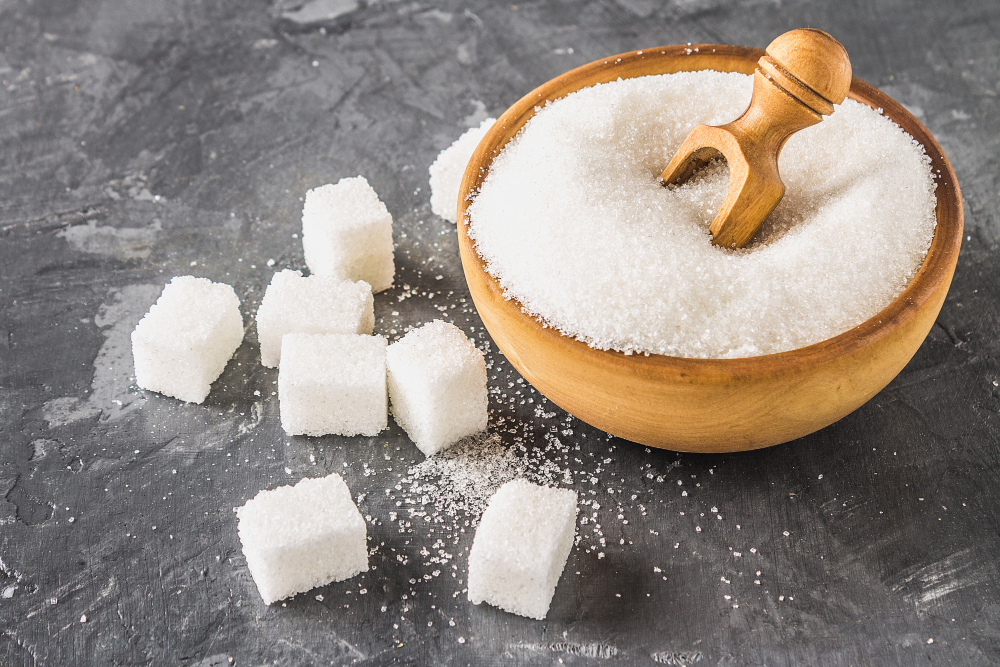To what extent is sugar dangerous?

|
Getting your Trinity Audio player ready...
|
Statistically speaking, each French person consumes from 25 to 35 kilograms of sugar each year, and that’s without other things containing sugar, such as honey, fruit juice, or tinned fruits, which add another 10 kilograms per year. But we don’t actually need all of this, since the carbohydrates found in bread and pasta are enough to give us the energy we need. From this, our organism can then produce glucose – the sugar our cells use as a source of energy.
As such, sugar brings nothing to our organism except superficial calories, which are known to make us gain weight. These past few years, scientists have found more and more proofs that sugar is actually not good for our health.
Obesity and illnesses caused by sugar
Saccharose (table sugar), is formed by glucose, also called grape sugar, and fructose (fruit sugar). Both are treated differently by our organism:
Glucose goes directly into the blood, and the body then uses it thanks to the insulin hormone, which guarantees that the glucose is absorbed by the cells. There, it acts as a rapid energy supplier. The excess energy is stocked as fat. Glucose also quickly increases the levels of insulin.
If we eat sugar constantly, the amount of sugar and insulin in our body increases constantly as well, which can lead to an insulin resistance: the cells become immune to insulin. Type 2 diabetes develops, and consequences can range from heart attacks, vascular, renal, and nervous lesions, or even a stroke.
Fructose has less effect on blood sugar, but it doesn’t fill you either and it damages the liver. Fructose is processed by the liver, and if there’s more fructose than it can process, the liver turns it into fat, which is stocked in the liver and augments the risks of inflammation. Other organs may also be at risk of growing.
Research also shows another danger of fructose: it is less satiating than the other sugars, meaning we may consume more of it. It also stimulates the formation of fat deposits. Even children can develop a hepatic steatosis because of a large consumption of sweets (such as Bêtises de Cambrai), similar to those of alcoholics. It can be an early sign of several illnesses: diabetes, cardiovascular diseases, strokes, and obesity.
Fructose hidden in numerous foods
More and more products are sweetened with fructose: ketchup, ready meals, sauces, or muesli. The word ‘fruit’ gives the impression that the sugar is harmless, which is why some manufacturers promote it. But fructose is just as calorific as other sugars, it isn’t healthier. Sometimes, fructose isn’t even listed in the ingredients, because there currently isn’t any labelling rules regarding fructose. This is a problem, notably for fructose-intolerant people who may develop health problems because of it.
Even slim people shouldn’t eat too much sugar
Is it okay to keep eating sugar even if you don’t gain weight? Not necessarily, because the insulin balance can also be disturbed in slim people. Just because you eat a lot of sugary food (especially fructose) doesn’t mean you’re going to gain weight.
However, there are what we call thin fat. People are slim, but their organs are covered by layers of unhealthy fat. About 15% of people who have type 2 diabetes are slim. They can also be affected by other illnesses, such as cancer.
There’s more sugar in juices and smoothies than in fruits
A lot of people underestimate the sugar content of fruit juices and smoothies. Depending on the fruit, some smoothies contain more sugar than coke, because they’re made from fruits in a highly concentrated form, with their natural sugar content. However, you can’t eat as many fruits as those who are in juices or smoothies. When the fruits are mashed, their fibres are destroyed, which means that sugar will end up rapidly in the blood.
People who eat fruits instead of drinking juice therefore absorb less glucose and fructose. Fruits are also harder to digest than juices, which means that glucose is absorbed slower, which in turn makes the insulin level increase slower.
Smoothies are best consumed moderately, just like sweets, but the best thing to do is to eat actual fruits instead. However, some fruits such as seedless grapes need to be eaten moderately, because they contain a lot of sugar. You can almost see them as sweets. Berries on the other hand, like raspberries or blueberries, contain less sugar.
Sugar as medicine
Sugary flavours sell well, therefore almost all ready meals contain sugar as a flavour enhancer. It’s also used in the food industry as a low-cost expense. But sugar stimulates the same parts of the brain as alcohol or nicotine, and it’s been proven that sugar can create an addiction. Scientists from around the world are looking into the subject, and there are also studies about whether or not sugar can increase the risks of cancer, or if a sugar-free diet can help prevent this illness.
At what point does sugar become unhealthy?
The maximum amount of ‘free sugar’ (meaning, added sugar) recommended per day by the World Health Organisation (WHO) is 25 grams (approximately 6 tablespoons).
This therefore isn’t only about the lump of sugar used in coffee, but every type of sugar that we consume throughout the day in yogurts, ready meals, ketchup, muesli, or jam. Foods with a natural sugar content – such as milk – aren’t included.
Statistically speaking, no one should eat more than 9 kilograms of free sugar per year. In reality however, it is 34 kilograms of white sugar, 9 kilograms of added sugar (sirup, glucose, and fructose) and 1 kilogram of honey – adding up to a total of 44 kilograms of sugar per person per year.
Sugars hidden in finished products
Numerous finished products and products from fast food restaurants contain a lot of sugar. For example, there are 9 lumps of sugar in a frozen salami pizza, 39 in so-called ‘fitness muesli’, and 9 in a pack of potato salad from the chilled section. There’s a lot of sugar in sweets but also in a lot of savoury foods: for example, there are 25 lumps of sugar in 700 grams of red cabbage. A 200-gram fruit yogurt contains 8 lumps of sugar, and 100 grams of cornflakes contains 12.
Sugar is often used in processed foods as a binder, a preservative, or as compensation in low-fat foods. Because they don’t have a lot of fat, they don’t taste good, so manufacturers add sugar. The saying ‘lower sugar content’ only means it has 30% less sugar than similar products. It is therefore preferable to look at absolute quantities in the list of ingredients. The sentences ‘only with a natural sweetness’ ‘without added sugar’ or ‘100% fruits’ only hide the fact these products contain a lot of sugar.
Beware of marking
If you want to eliminate sugar, you’ll have to be watchful: the food industry likes to hide sugar behind a lot of different names in the list of ingredients:
- Glucose
- Fructose
- Sugar (table sugar contains glucose and fructose in a 1:1 ratio)
- Saccharose is another word for table sugar
- Maple sirup
- Whey powder
- Corn sirup
- Isoglucose (can contain up to 90% of fructose)
- Glucose-fructose sirup (less than 50% of fructose)
- Fructose-glucose sirup (between 50 and 90% of fructose)
- Lactose, maltose, malt extract
Alternative sweeteners: expensive sugar
Alternative sweeteners such as maple sirup, agave sirup, pear sirup, and apple sweetener are largely made of sugar, and often contain large quantities of fructose. They offer more minerals, but are barely less calorific and are a lot more expensive than sugar. This is also the case of coco sugar (made from the flowers of the coconut tree), which contains 70 to 90% of saccharose, which is sugar table. However, it’s been proven that blood sugar increases a bit slower after eating this sugar. This is also the case for isomaltulose.
Unlike traditional sugar, yacon sugar, made from yacon roots that grow in Peru, is composed not only of 2 elements, but also from a longer molecular chain, which makes it more a dietary fibre. It therefore contains half the calories of sugar, but it is also less sugary.






